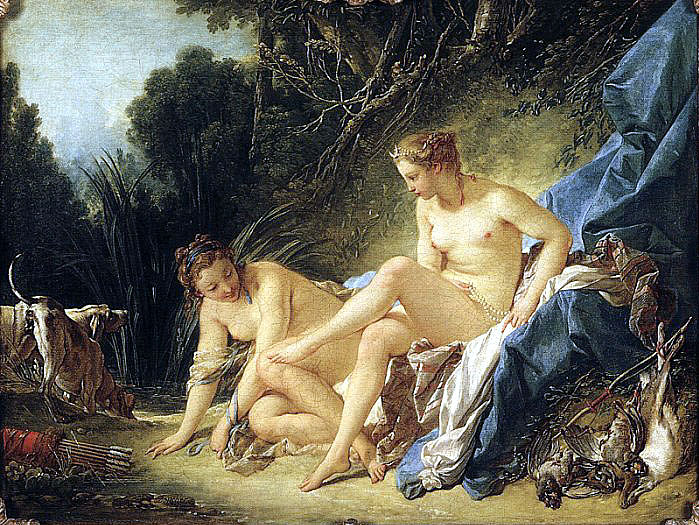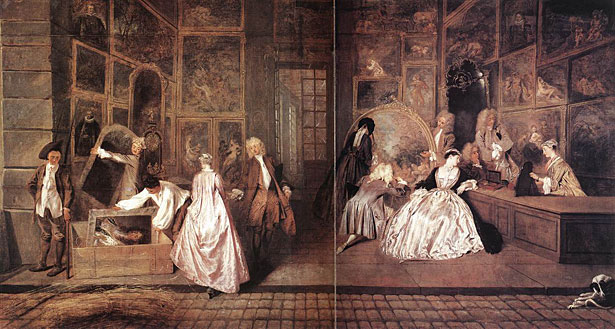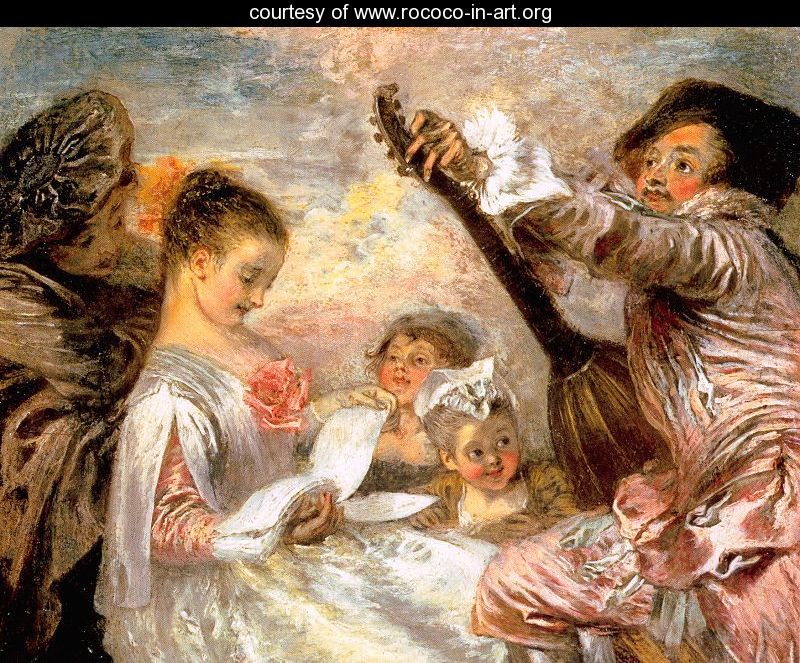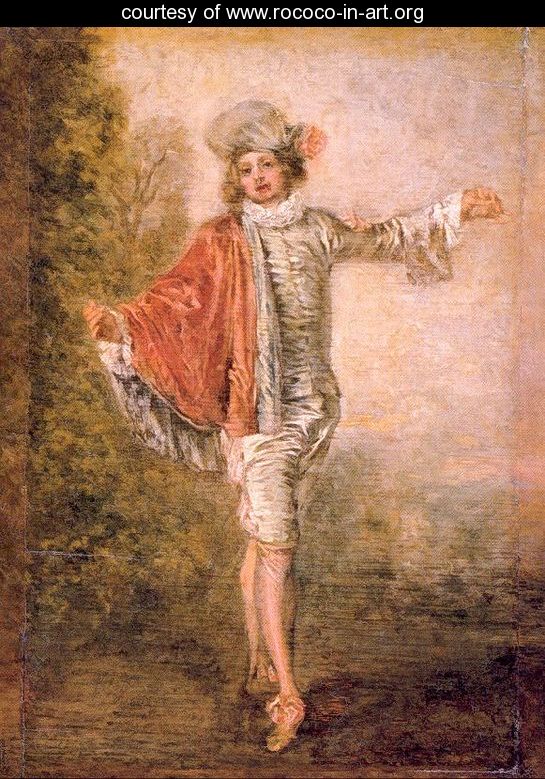Jean Antoine Watteau( 1684-1721) was thirty-three when he painted “Embarkation” . Two years later in 1719 he went to London to sonsult Dr. Richard mead, the queen’s physician, and was there subjected to such treatment as the best medical knowledge could provide to treat his tuberculosis. He returned within months to find that his cousin Julienne had managed his affairs so well that he had accumulated some money in spite of the panic caused when an outgrowth of Antoine Crozat’s specualtion in the New World, the fabulous “Mississippi Bubble” burst that year.

Fragonard. The Swing. otherwise known as the Happy Accidents of the Swing was commissioned by a titled aristocrat who gave the painter precise instructions as to the pose of the figures, and then, with his mistress, served as the model for the painting. Thus this gay and frivolous scene, like he artist, epitomizes French manners and taste in the years immediately preceding "le déluge."
Now he moved in with his old friend Gersaint, who, as the son in law of his old dealer, Sirois, had taken over the business. In gratitude Watteau painted for Gersaint the famous signboard that rivals the “Embarkation” as his finest work. It shows the interior of the shop as if seen from the street with the front wall removed- customers are being received, others are examining paintings, workmen are boxing a portrait for shipment. Divided betweeen genre and poetics, or rather, fusing the two; it is the unique example in Watteau’s work that might justiy for us the label of realist that seemed appropriate enough to his contemporaries.
Early in 1721 Watteau left paris for Nogent-sur-Marne, where he hoped the air would help him. But he knew he was dying. The extremity of his illness seems to have caused a change in his character. His friends had noticed, upon his return from London, that he had become avaricious. With his life ebbing, he became concerned about the practical future. For the first time he complained about the prices his paintings fetched. He had never given any indication of worrying about his soul: now another future also concerned him. He painted a “Christ on the Cross” as a gist for the local curé, and destroyed a number of paintings and drawings that he feared were erotic. He died in the arms of Gersaint on July 18, 1721, threee months before his thirty-seventh birthday.

Bath of Diana. Boucher. Boucher"s figures are sensual, earth bound, and unfailingly decorative:But the goddess herself is presented only as a ravishngly pretty, rather demure girl. Like her companion, she is reality idealized, divinely blonde (with not a strand of hair out of place), slender, touched with a voluptuous vacancy on her face, a lack of animation which increases her charm. Her features reveal nothing of the hard-hearted goddess of the hunt, despite the tropies near her. Instead, this is a totally human woman; Boucher's idealizing touches are restricted to the refining of ankles and wrists, perfecting the arc of the eyebrows, tinting a deeper red the lips and nipples. Yet herself so desirable, Diana seems without desires, with an innocence that borders on stupidity. d unfailingly decoratived unfailingly decorative:
Immediately after Watteau’s death, Julienne began the compilation of all his existing works- pictures, drawings, and the decorations he had painted as assistant to Audran-in the form of engravings. This was the monumental tribute and record called the “Recueil Julienne” .It was not until this work appeared that Watteau became known to anything like a large public. It also made his work an international influence of painters for the rest of the century, although only to the extent that they adapted his subjects or copied his motifs. He had achieved the ideal statement of a far from ideal society during a single decade of its existence, and in spite he found no followers.

Watteau. Shop Sign of Gersaint. Monika Szewczyk:There is great interest nowadays in representing networks. The recent disclosure by the makers of Facebook that they will not fully delete records of their users—even those who choose to deactivate their accounts—underscores a somewhat paranoid logic that potentially preys on friendship as a mapping of consumers that lead to more consumers. It is with this in the back of my mind that I look at both of Watteau’s aforementioned paintings. The shop sign in the form of a painting was made for the art dealer Edme-François Gersaint and shows people evaluating and appreciating other paintings. The mass and mobility of these pictures—which are no longer attached to castle or church walls (as was customary for major commissions until about the 15th century), but can be packed in a crate (as shown on the left) and shipped to hang in anyone’s home—are a source of titillation. This early picture of the art market makes a point of exhibiting conversation as a basis of the market transaction. In some ways, conversation is the real value being exchanged; or it might be said that conversations arise in the places where value must be negotiated.
In actual practice, however, he found two, both a few years younger than he: jean baptiste Francois Pater ( 1695-1736) and Cicolas Lancret ( 1690-1743). Pater was by birth Watteau’s fellow townsman, by training his pupil, and by intention his second self in art, copying his style as well as literally copying his paintings. During the last years of Watteau’s life he and Pater were reconciled after a quarrel, and apparently he regarded pater as his aesthetic heir. But pter was often a careless painter and, in contrast ot Watteau’s subtlety, an obvious one who reduced Watteau’s transmutation of sexual byplay to the level of amorous anecdote. The best Pater only makes you wish for a real Watteau.

Watteau. Gilles and his family. 1716."Mauclair does not like the coupling of Watteau's name with those of Boucher, Pater, Lancret, De Troy, Coypel, or Vanloo. They imitated him as to externals; the spirit of him they could not en-snare. If Watteau stemmed artistically from Rubens, from Ruysdael, from Titian (or Tiepolo, as Kenyon Cox acutely hints) he is the father of a great school, the true French school, though his stock is Flemish. Turner knew him; so did Bonington. Delacroix understood him. So did Chardin, himself a solitary in his century. With-out Watteau's initiative Monticelli might not be the Monticelli we know, while Claude Monet, Manet, Renoir are the genuine flowering of his experiments in the division of tones and the composition of luminous skies. Mauclair smiles at Caylus for speaking of Watteau's mannerisms, the mannerisms that proclaim his originality. Only your academic, colour-less painter lacks personal style and always paints like somebody he is not. Watteau's art is peculiarly personal. Its peculiarity — apart from its brilliancy and vivacity — is, as Mauclair remarks, the contrast of cheerful colour and morbid ex pression." Morbidezza is the precise phrase"...
Lancret, who, like Watteau, was trained under Gillot, followed Watteau’s manner more closely but missed his spirit even more completely. He is often so explicitly an illustrator, as in “The Picnic After the Hunt” that earns for himself Jeurat’s description of Watteau as a painter who marvelously imitated nature. “Painters after Nature” became the tag attached to any french artist of the time who worked in an informal manner as opposed to the “grand manner” that still ruled the Academy.
 "585" height="468" />
"585" height="468" />Lancret. Picnic After the Hunt.1738.
Actually, the grand manner had become an anachronism with the death of Louis XIV, but Watteau had never been sufficiently conspicuous to threaten its conventional popularity. The break was made by Francois Boucher ( 1703-1770) , who as an ambitious youngster had worked on the engravings of the “Receuil Julienne” . Watteau had been a private painter. Boucher was an aggressively public artist who came to rule the Academy as court painter to Mme de Pompadour and effected the perfect compromise between high society,s public ambitions toward aesthetic learning and its private preoccupation with erotic stimulation. He rescaled the pomposities of he old style, bringing them into harmony with the feminine intimacy of the eighteenth century drawing room.

Watteau. harlequin and Columbine."The riddle is solved by Mauclair: These flights into the azure, these evocations of a country west of the sun and east of the moon, these graceful creatures of Watteau, the rich brocade of Chopin's harmonies, the exquisite pictures of Keats, the youthful joy in far-away countries of Stevenson, all, all are so many stigmata of their terrible affliction. They sought by the magic of their art to create a realm of enchantment, a realm wherein their ailing bodies and wounded spirits might find peace and solace. This is the secret of Watteau, says Mauclair, which was not yielded up in the eighteenth century, not even to his followers, Pater, Lancret, Boucher, Fragonard, whose pagan gaiety and artificial spirit is far removed from the veiled melancholy of Watteau."
Boucher’s “Bath of Diana” is sufficient demonstration of both his merits and shortcomings. In many ways a delicious picture, it puts the goddess into the typical Boucher mold of a nubile grisette whose seductive, if slightly rubbery, pinkness is sweetly set off by moist lips and golden locks. Upon fresh, tiny-nippled brasts, jewels might lie as if upon a jeweler,s cushion. A superb craftsman-designer with an infallible sense of decoration, Boucher did not think of paintings as independent statements, or statements of any king apparently, but rather, as part of a decorative ensemble. In his way he has never been surpassed. He became the Rubens of the Boudoir, the boudoirs where Rubens would have seemed grossly overstated and out of scale.
We cannot call this a Watteau tradition; it is offered only as an example of the French world of elegance and cultivation that Watteau had poeticized, as it was interpreted at mid-century. The end of the sequence came with Jean Honoré Fragonard ( 1732-1806) , a pupil of Boucher who is so appealing that he inspires absolutely unsupportable reveries-such as that he and Watteau would have got along beautifully if they had known one another; that Fragonard was what Watteau might have been if he were a participant instead of an observer of the now decaying society.

Watteau. The Music Lesson.1719."Watteau was a consumptive; he died of the disease. A consumptive genius! It is a hard saying. People of average health whose pulse-beat is normal in tempo luckily never realise the febrile velocity with which flows the blood in the veins of a sick man of genius. But there is a paradox in the case of Watteau, as there was in the case of Chopin, of Keats, of Robert Louis Steven-son. The painter of Valenciennes gave little sign of his malady on his joyous lyrical canvases. Keats sang of faëry landscapes and Chopin's *as a virile spirit; the most cheerful writer under the sun was Stevenson, who even in his Pulvis et Umbra conjured up images of hope after a most pitiless arraignment of the universe and man. And here is the paradox. This quartet of genius suffered from and were slain by consumption. (Stevenson died directly of brain congestion; he was, however, a victim to lung trouble.) That the poets turn their sorrow into song is an axiom."
“Delightful” may be an adjective of minimum praise when it is employed to summarize a painter’s work , indicating that his achievement is something less than impressive; in Fragonard’s case, we can make it “consummately delightful” to give credit to the most underrated artist of pre-revolutionary France.
There must have been no young blade in Paris who enjoyed the city’s special pleasures more than Fragonard did. Like Watteau, he found affluent patrons who were not only “bon vivants” but also eighteenth century “amateurs” of the most cultivated type. He was tremendously successful not only as a painter but also as a personality; his name was affectionately shortened to “Frago,” and his conquests included some impressive names among the ladies of the demimonde.

Watteau. The Toilette."None of Watteau's contemporaries fathomed the meaning of his art: not Count de Caylus, not his successors, who all recognised the masterly draughtsman, the marvellous colourist, the composer of pastoral ballets, of matchless fêtes galantes, of conversations, of miniatures depicting camp life, and fanciful decorations in the true style of his times. But the melancholy poet that was in the man, his lyric pessimism, and his unassuaged thirst for the infinite — these things they did not see. Caylus, who has left the only data of value, speaks of Watteau's hatred of life, his aversion at times from the human face, his restlessness that caused him to seek new abodes — Chopin was always dissatisfied with his lodgings and always changing them. The painter made friends in plenty, only to break with them because of some fancied slight."
Frago was as skilled a decorator as Boucher, and alone among the eighteenth-century French painters of fashion had a sensitivity comparable in degree, although not in character, to Watteau’s. There is nothing that Frago could not do, except what Watteau did: he could not rise above the society of gallant caprice in which he moved with such zest. If he had tried, he would likely have broken his bootstraps.
But few artists are so complete within their boundaries as Fragonard is within his, and it is absurd to mistake these boundaries, which could include a painting like “The Swing” , for the limitations of a minor talent. An art of consummate delight, after all, can be created only within boundaries that ignore most of the world. Fragonard and Boucher drew their material from essentially the same society. But for Watteau, it was, as the English critic Walter Pater wrote in the nineteenth century, “that impossible or forbidden world which the mason’s boy saw through the closed gateways of the enchanted garden.”

Watteau. Indifferent Man." A gallant artist, he was not a gallant man, He had the genius of friendship but not the talent for insuring its continuity. Like Arthur Rimbaud, he suffered from the nostalgia of the open road. He disappeared frequently. His whereabouts was a mystery to his friends. He did not care for money or for honours. He was elected without volition on his part as à member of the Academy. Yet he did not use this powerful lever to further his welfare. Silent, a man of continent speech, he never convinced his friends that his art was chaste; yet he never painted an indelicate stroke. His personages, all disillusionised, vaguely suffer, make love without desire — disillusioned souls all. L'Indifférent, that young man in the Louvre who treads the earth with such light disdain, with such an airy expression of sweetness and ennui, that picture, Mauclair remarks, is the soul of Watteau. And, perhaps, spills his secret."
ADDENDUM:
Monika Szewczyk: Sure, I am reading into the picture—speculating, projecting, appreciating it in a way that might not be appreciated by scholars—but I do see a speculative sense of value in L’Enseigne de Gersaint that may account for the greater sense of tension in this image—greater even than is perceptible in Watteau’s earlier depiction of a pilgrimage to the Island of Cythera, the ludicrously lovely dwelling place of Aphrodite.If the earlier painting is gratuitously graceful—to my eyes at least—the heavenly element (embodied by the putti in the background of Le Pèlerinage à l’île de Cithère) is gone from the shop sign (and perhaps this is the reason for the midsummer melancholia of the embarkation). I’ll even play a little faster and looser with art history still, and posit that perhaps this grace has been replaced by another “other” in the very front of the picture—a dog that is quite obviously not taking part in the conversations at Gersaint’s shop. Since “dog” only spells “god” backwards in English, it is unlikely that Watteau was thinking in the same vein—seeing divinity in an animal and thus a true “other” to converse with—but even in French they say “Le bon Dieu est dans le détail,” and this one needs some attention.
I’ve always been told that dogs in paintings are code for some abstract notion of “loyalty,” but this one’s not very convincing. If anything, he denaturalizes the entire scene. And if the dog refuses to play his allegorical part, his presence on the edge of the frame may be pointing to the fact that the pictures are framed, movable, and thus of continually reframed value. Looking at that oddly placed dog in Watteau’s painted conversation, I wonder how we fit into this picture. On a couple of occasions, I have heard Martha Rosler confront her interlocutors in a public forum with the problem of forgetting about bohemia. For her, the staginess of conversations nowadays has evacuated some of the fun and much of the real political force from what she experienced when people gathered together in the sixties and seventies. But the real problem seems to be a kind of waning of a particular class-consciousness—a sense of common values involving a self-imposed poverty for the sake of other riches. Maybe Watteau’s dog is a budding bohemian, or better still Diogenes, the “dog philosopher” who, when asked by Alexander the Great if the admiring Omnipotent could grant him any wish, any riches, simply requested that the emperor get out of his sun. The question of class might become more interesting if we begin to ask ourselves whether it is not just bohemia, but the middle class, that is being eclipsed—and with what….





 COMMENTS
COMMENTS
Glad to see someone appreciating Watteau.
The Watteau Society, London.
thanks for reading Selby. Best